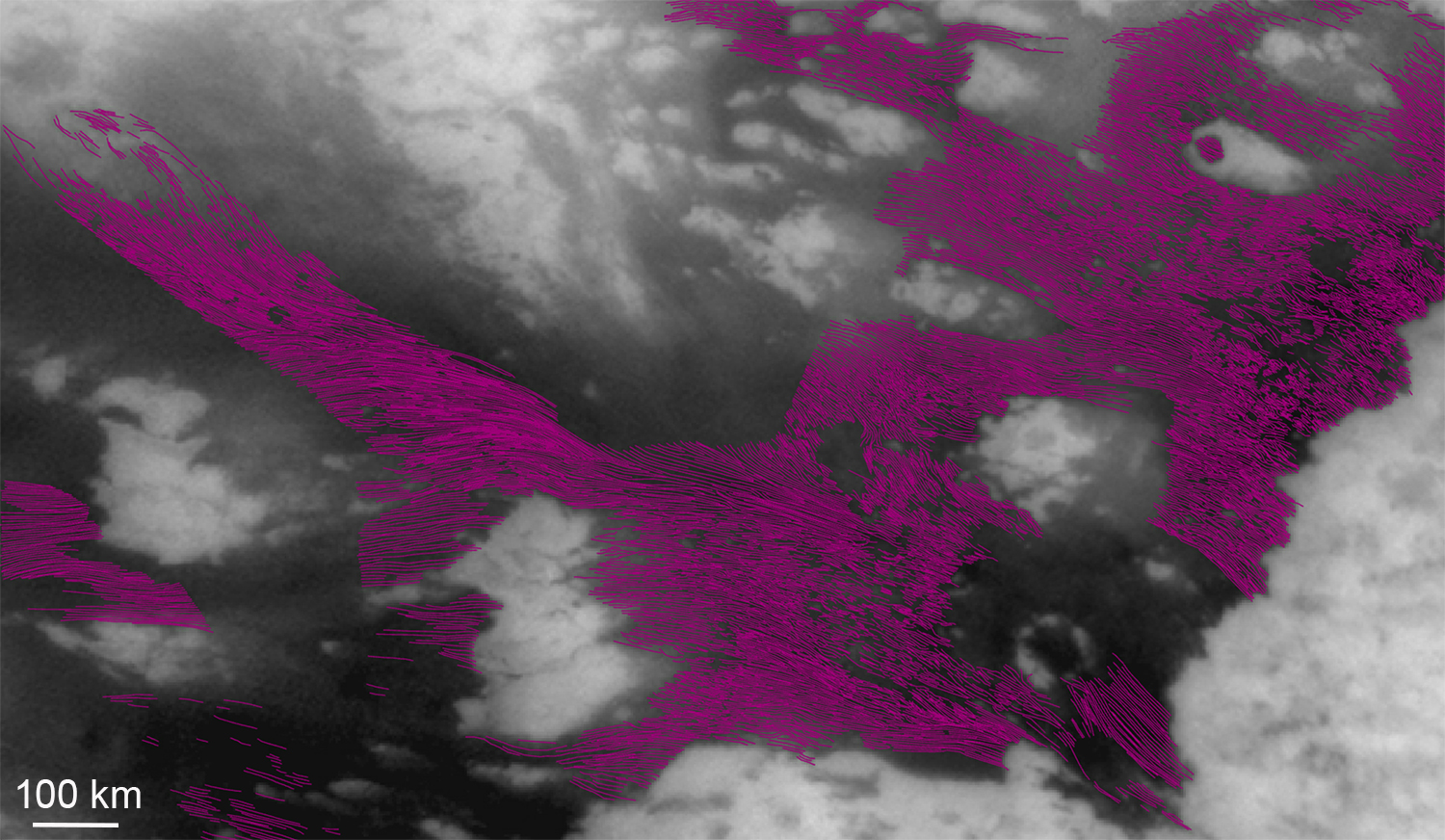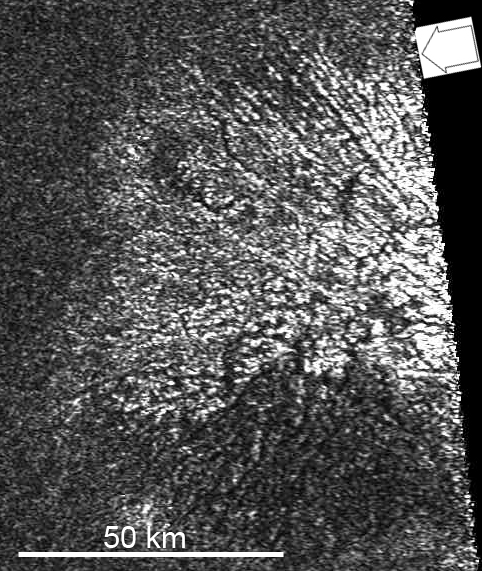Eolian landforms and processes on Titan and role in material movement
- 1Brigham Young University, Geological Sciences, Provo, United States of America (janirad@byu.edu)
- 2NASA Jet Propulsion Laboratory, Pasadena, CA, USA
- 3Stanford University, CA, USA
- 4Institut de Physique du Globe de Paris
- 5Johns Hopkins University Applied Physics Laboratory, MD, USA
- 6University of Idaho, Moscow, ID USA
- 7Texas A&M University, TX USA
The surface of Titan is composed of varied geomorphic units indicative of a vivid depositional, erosional and tectonic history. Dominant at Titan's equatorial regions are vast eolian landscapes of dunes, sand sheets, yardangs and wind streaks. These features reveal the action of wind in time and space, which has moved and shaped unconsolidated materials across the surface. Cassini Visual and Infrared Mapping Spectrometer (VIMS) spectra of these materials are most consistent with organics, and particle sizes from Cassini Synthetic Aperture Radar (SAR) vary from dust to cobbles [1]. Most grains appear to be sand-sized, based on the predominance of SAR-dark (smooth at 2 cm) material organized into dune forms at the equator, and models for wind requirements to build dunes on Titan [2]. Dunes cover ~15% of Titan’s surface, or 13 million km2 [3, 4] in the form of linear dunes 1-2 km wide and spaced by 1-4 km [5]. This type and size of dune is dominant in the Arabian and African deserts and is also known as longitudinal [6], referring to the net direction of the transport of sand, which aligns with dune crests [7, 8].
All dunes visible in the Cassini SAR imagery have now been traced down their long axes, revealing regional and global orientations (proxy for wind) and distributions, controlled by obstacles and regional elevations. Over 30,000 dunes have been traced (Fig. 1), and given SAR image coverage, this represents ~40% of all dunes thought to be present based on sand sea locations from the Cassini Imaging Science Subsystem (ISS), meaning we may expect as many as 75,000 dunes to exist on Titan. A total dune length of 1.309 million km has now been calculated from the measured dunes; extrapolated to all of Titan, this length would be 3.273 million km. Using an average dune width of 1 km and corresponding height of 100 m from a 0.1-0.2 dune height:width relationship [9] and isolated measurements [10] we find a total measured dune sand volume of 130,900 km3. If scaled up to all dunes thought to be present, the total volume of sand from dunes alone of 327,250 km3 falls within previous estimates for sand volumes [11, 4, 12]; however, those studies also included sand sheets without detectable dunes. Thus, this new measurement may reveal greater sand volumes from dunes alone than previously thought. This represents a significant material volume that has been moved through wind action, even if from locations close to the (unknown) source.
At higher latitudes, several distinct regions of SAR-bright dunes or wind-carved ridges or yardangs are also present (Fig. 2). These can be found in flat plains [13], where they may be inactive dunes, or on the elevated, fluvially carved domes of the midlatitudes, postulated to be volcanic laccoliths [14]. Ash or otherwise derived fine organic grains would be ideally soft yardang materials, comparable to those on Earth, and reveal that winds can also remove substrate on Titan, similar to the action of wind in locations on Mars [15]. Statistical comparisons between possible yardangs support their existence on the domes but are consistent with them being dunes in other locations [16]. The dome yardangs would have resulted from removal of fine-grained materials and loss to the atmosphere as airborne particles and eventually other surfaces – new estimates of the volume of yardang erosion on one small dome, based on yardang heights of ~100 m from shadows, is ~125 km3, and there are a handful of identified other similar yardang regions. Creation of dust from dune sand movement has not yet been estimated (and there are significant uncertainties about material properties) but with yardang processes could yield large volumes that now reside in unknown locations, including interdunes, high latitude plains, lakes and seas. SAR and ISS bright streaks are visible at low to midlatitudes on Titan, similar in orientation to the dunes where they overlap, and found behind obstacles [17, 18]. Their SAR brightness is consistent with a larger particle size, which may be supported by lower density materials, but wind streaks are also often identified with fine particle sizes. This reveals yet another sand and dust location on Titan. Yardangs and wind streaks, along with the ubiquitous equatorial dunes, confirm a general W-E flow of wind, with some N or S deviations that may be reflections of a global undulatory wind pattern at high latitudes.
The Dragonfly mission will study dune regions in depth and will reveal particle sizes and compositions, nature of the interdune, level of dune activity and sand (and perhaps dust) movement at the present day, and magnitude and direction of modern winds [19]. These observations will anchor our understanding of eolian processes in the Solar System.
[1] Le Gall, A. et al. 2010, Icarus 207, 948-958. [2] Lorenz, R.D. et al. 2006, Science 312, 724-727. [3] Le Gall, A. et al. 2011, Icarus 213, 608-624. [4] Rodriguez, S. et al. 2014, Icarus 230, 168-179. [5] Radebaugh, J. et al. 2008, Icarus 194, 690-703. [6] Courrech du Pont et al. 2024; Earth-Science Reviews, 104772. [7] Lorenz and Radebaugh 2009; Geophysical Research Letters 36. [8] Lucas et al. 2014; Geophysical Research Letters 41, 6093-6100. [9] Lancaster, N. 1995, Geomorphology of Desert Dunes. [10] Neish, C.D. et al. 2010. Icarus 208, 385-394. [11] Arnold, K. 2013, BYU MS Thesis. [12] Lorenz, R.D. et al. 2008, Geophysical Research Letters 35. [13] Lopes, R. et al. 2020. Nature Astronomy 4, 228-233. [14] Schurmeier, L. et al. 2023, Icarus 404, 115664. [15] Kerber, L. et al. 2011. Icarus 216, 212-220. [16] Northrup, D. et al. in progress. [17] Malaska, M.J. et al. 2016. Icarus 270, 183-196. [18] Cohen-Zada, A. et al. 2016. Aeolian Research 20, 108-125. [19] Barnes, J.W. et al. 2021. The Planetary Science Journal 2, 130.

Fig. 1. Dunes traced in Shangri-La region of Titan. ISS basemap. Dunes may still be present in large, dark areas, though there is not SAR coverage.

Fig. 2. SAR-bright yardangs on an eroded dome. From T64, northern midlatitudes. Arrow shows SAR illumination direction.
How to cite: Radebaugh, J., Wright, M., Rose, D., Kerber, L., Lapôtre, M., Rodriguez, S., Lorenz, R., Barnes, J., Marvin, C., and Cohen Zada, A.: Eolian landforms and processes on Titan and role in material movement , Europlanet Science Congress 2024, Berlin, Germany, 8–13 Sep 2024, EPSC2024-613, https://doi.org/10.5194/epsc2024-613, 2024.